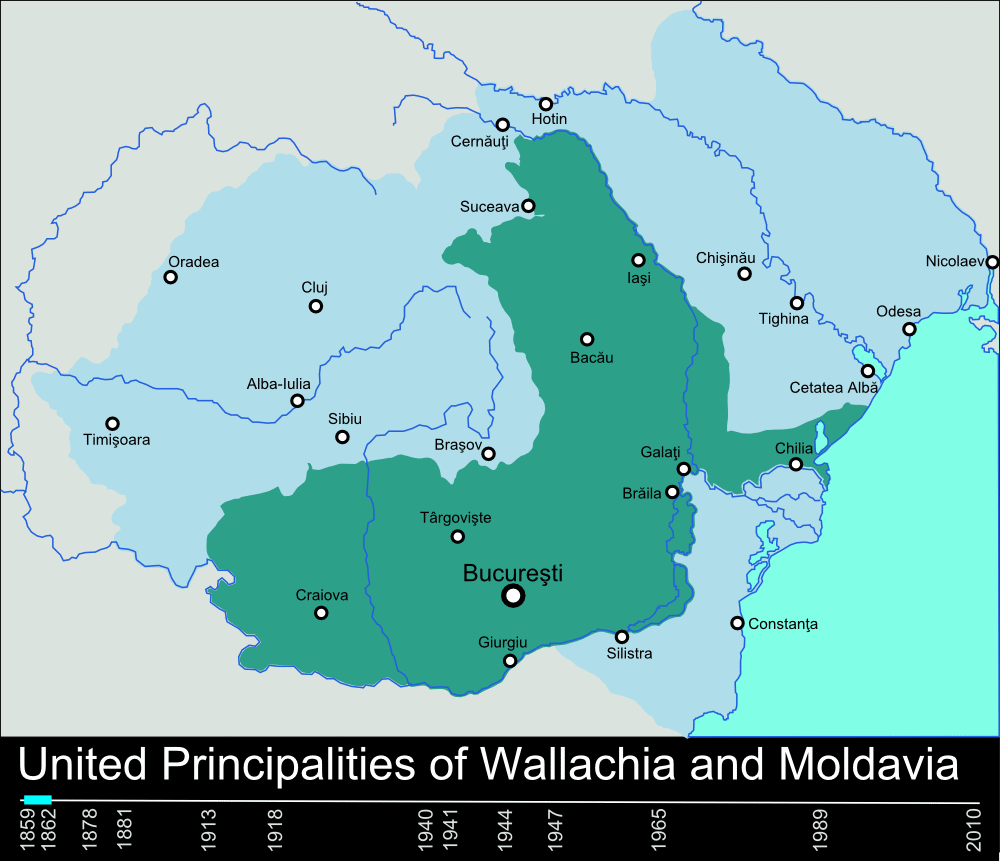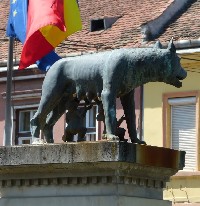A little historical background
Perhaps, as for me, Romania has been a bit of an enigma to you? This mystery has been partly due to one of the most convoluted and complex political histories in the world.
Modern Romania consists of a number of more ancient kingdoms or principalities that have been fought over ever since the advent of agriculture when wealth came to be synonymous with the possession of good farmland. In the 20th century oil was added to the list of Romania's riches.
Competing empires for these lands included: the Roman; the Byzantine; the Ottoman; the Austro-Hungarian; the Russian; the Napoleonic; and the German. Historians might list several more (Swedes, Vikings?). There are numerous cultural remnants of these struggles and the language is interesting for its familiar words from Latin and German dotted through it, like raisins in a bun.
Principal among these older kingdoms in the region were the lands of Wallachia and Moldavia, later joined by Transylvania. But the borders of 'Romania' have been fluid, incorporating and excluding neighbouring lands as the local balance of power and influence waxed and waned in the adjoining empires. The present country dates back to 1859 but since that time it's boarders have been fluid and it has undergone some big changes in government.

By User:Scooter20 [Public domain], via Wikimedia Commons
In the early 19th century the principalities of Wallachia and Moldavia were 'suzerains' (self governing vassals) of the Ottoman Empire and were ruled by local princes or 'domitors'. But in 1862 a single prince, Alexandru Ioan Cuza, became domitor of both principalities, uniting them in what was to become Romania. Four years later another, Prince Carol, sized power in a palace coup d'état.
Constitutional Monarchic Romania
Thus in 1866 the first Constitution of Romania enshrined Prince Carol as ruler. The throne was made an hereditary office to be held by the male descendants of Carol. Legislative power was to be exercised by the Prince and Parliament (composed of an Assembly of Deputies and a Senate), while executive power was entrusted to the Prince, who exercised it through his ministers.
Voters were divided into colleges based on their wealth and social origins. The Prince's constitutional powers were similar to those of a monarch in contemporary constitutional monarchies. Citizens' rights enshrined in the Constitution included the freedoms: of conscience; of the press; of assembly; of religion; equality before the law, regardless of class; individual liberty; and the inviolability of the home. Capital punishment was abolished in peacetime. Yet, the Romanian Orthodox Church was declared 'the dominant religion' of the Romanian state. And despite the freedoms of religion and of conscience, non-Christians, like Jews, could not become citizens and therefore, like those other strange creatures, women, couldn't vote.
This Constitution was given full legitimacy in 1881, when Romania was declared an independent country, with King Carol I as ruler, in the Treaty of Berlin, after the Ottoman Empire was defeated in the Russo-Turkish War of 1878.
King Carol ruled for 33 years but then died, as do we all. In this case he ceased to be in October 1914, three months into the First World War (WW1). He left no direct heirs and so a nephew, Ferdinand, together with his influential English consort, Princess Marie of Edinburgh, ascended to the throne.
After initial alliance with pre-revolutionary Russia, Romania, which has strategically important oilfields, was forced into neutrality, but effectively in support of Germany, . At war's end in 1918, taking advantage of the power vacuum created by the Armistice, the county was amalgamated with Transylvania, Eastern Moldavia (Bessarabia), and Bukovina. Ferdinand got the credit and was nicknamed: Intregitorul, the unifier. In celebration, in 1921 Italy gave the new expanded country five copies of the 'Capitoline Wolf' to place in strategic locations to represent the new Romanian unity and their 'Latinity'. This is a bronze statue, of the Roman she-wolf with Romulus and Remus, suckling beneath her that was thought, at the time, to date back to the 5th century BCE *.
During the interwar period Romania remained a constitutional monarchy and some progress was made towards improving the life of the peasants, who made up the vast majority of the population, and Romania embraced industrialisation, particularly in armaments. Meanwhile the new federation immediately went to war again, this time to oust the Bolsheviks from Hungary.
In 1927 Ferdinand I died to be succeeded by his young grandson Michael I. Then 1930 as a result of parliamentary changes Michael was obliged to abdicate in favour of his father, Carol II. In 1938, in the lead up to the Second World War (WW2), Carol II assumed total power as 'Royal Dictator'.
* For those of you unaware, in legend Romulus and Remus were the founders of Rome. They were twin boys, born of a vestal virgin who had been inseminated by the God Mars. The king, fearing them as possible rivals, had them 'exposed' to die by the Tiber. But with the intervention of Tiberinus, the God of the river, they were suckled by a she-wolf and thus saved to found the city. These myths, that are represented on Roman coins as early as 269 BCE, were thus in general circulation long before the similar, and probably derivative, Christian myths.
Fascist Romania
When WW2 broke out in 1939 Carol had declared neutrality. But as Romania's borders crumbled and its allies were defeated the local Fascists quickly gained support. In 1940 there was a popular uprising against Carol and the Romanian Fascists sized power. Romania became a fascist dictatorship, under Mareșal Ion Antonescu and joined the Axis, with Germany and Italy. Romanian troops played a major role in Operation Barbarossa, the German invasion of Russia, where 370,000 were killed. Romanian troops and the Romanian dictatorship also assisted in the holocaust against the Jews abroad but mostly against the Romani at home. See the Appendix to this article.
Communist Romania
Towards the end of World War 2, the Fascist dictatorship was defeated by the Allies and the Constitutional Monarchy, with King Michael I at its head, was briefly reinstated. But in 1947 the king was forced to abdicate under Russian pressure and the Communist Party took control. With that Romania became part of the Warsaw pact. After a decade under tight Russian control, Romania began a separatist policy. So that by 1968 Romania was condemning the Soviet invasion of Czechoslovakia. But this was posturing for world attention during the cold war. Romania had escaped from a wartime Fascist dictator and Russian hegemony only to be captured by the increasingly bizarre Communist dictator: Nicolae Ceaușescu and his wife Elena. Under this government the economy ground to a halt and widespread poverty ensued.
Republican Romania
The Ceaușescu dictatorship ended with the Romanian Revolution of 1989, leading to elections in 1990 and a new constitution a year later.
Henceforth the President was to be democratically elected in two rounds for a maximum of two four (now five) year terms. Candidates cannot be members of any political party. As in the United States the President has similar powers to those of the former kings but as in the Westminster System must now act in consultation with a democratically elected bicameral Parliament (of 136 Senators and 329 Deputies) on the advice of a cabinet of Ministers, led by the Prime Minister. Suffrage includes all citizens 18 years and over. Voting is not compulsory.
Again thumbing its nose at Russia, Romania joined the North Atlantic Treaty Organization (NATO) in 2007 and the European Union (EC) in 2007.
Nevertheless Romania has not become a member of the European Monetary Union, the Euro zone. The The Romanian leu (lion) - plural lei - is subdivided into 100 bani (also meaning money). In August 2016 we got about 3 lei to the A$. This floating currency has allowed Romania to be competitive in Europe and it presently has one of the lowest unemployment rates in the EC. But the floating currency means that wages are relatively low and freedom of travel within the EC has allowed Romanians to take better paid jobs in the UK. This has been one of the forces behind the BREXIT movement in England.
Fortunes have changed quite dramatically across this country. In recent times, there were riots during the Global Economic Crisis. But then the economy began to recover and Romania is enjoying rapid growth again, as evidenced by: the number of late model German cars on the roads; diners in street cafés; evident rural prosperity; infrastructure projects underway; and private urban renewal in Bucharest.

